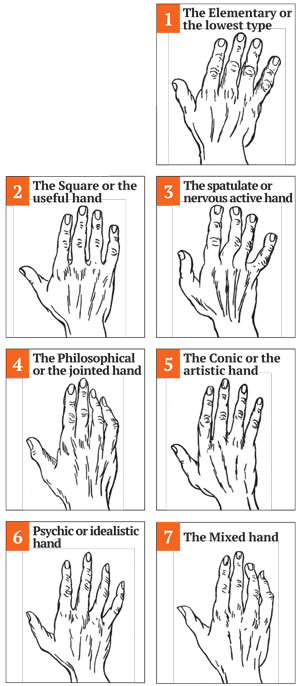03 Apr 2017 - {{hitsCtrl.values.hits}}
By A.S. Fernando
The shape of the hand provides a wealth of information relating to the character and the peculiarities of the subject, say great palmists who have gathered knowledge through research and experience.
The hand is divided into three distinct parts as

The Hand proper
The Fingers and
The Thumb
The Hand Proper (back)extends from the wrist to the lower knuckles of the fingers. The Palm proper (front) extends from the wrist to the base of the four fingers and of the Thumb.
The Fingers, four in number, each is divided into three phalanges, the first or the nailed one, the second and the third connecting with the Hand Proper.
The Thumb consists of two phalanges only. The lower portion of the Thumb is attached to the wrist and it is also one of the metacarpal bones forming the Palm Proper. It is not a phalange.
Readers have to note that the Hand as a whole is the back of the hand from the wrist to the finger tips.
The Hand Proper is the back of the hand from the wrist to the knuckles at the base of the fingers.
The Palm is the inside of the hand from the wrist to the base of fingers.
There are seven types of Hands each with a specific shape. They are:
The Elementary or the
lowest type
The Square or the useful hand
The spatulate or nervous
active hand
The Philosophical or the
jointed hand
The Conic or the artistic hand
Psychic or idealistic hand
The Mixed hand
The Elementary Hand as the name suggests is the lowest of all types of hand. It is characterized by stiff, thick fingers, a clumsy Thumb, the nailed phalanx turned back, a hard palm and shapeless finger tips. The hand as a whole is short and thick.
The owners of the elementary hand possess little mental development and skills developed by the brain. They fit into occupations requiring unskilled manual labour. They have a violent temper and are unable to bridle their passions. They are guided by instinct rather than by reason. They have no ambitions and are quite contented if they have enough to eat, drink and have a place to sleep.
The Square or the useful hand: This type of hand is called square hand because it is square in shape. Even the nailed phalanges of such a hand are square.
The Thumb of the Square type is, however, often long, well-shaped, set high on the palm and stands well away from the palm.
People with this type of hand are pragmatic, logical and materialistic. They are solid serious workers, not idealists or visionaries.
They are said to be narrow-minded respecters of the letter of the law. They are firm and resolute in their views, especially if their thumb is long and the first joint is stiff.
We can recognize this type easily when we see the back or the reverse of the hand. There are several knots on the fingers of this type of hand.
The Spatulate or the workman’s hand: It is usually crooked or irregular-looking with large finger tips. The nailed phalanges of the fingers of the Spatulate type present the appearance more or less of a flattened spatula. People with this type of hand are untiring persistent workers full of energy. They are inventive, unconventional and emotional.
Unlike the Square type, the Spatulate type possesses much imagination. These persons do not sit idle while the world passes by. Even if they are born poor, they would eventually rise to a high position by the dint of their perseverance.
(To be continued)
22 Nov 2024 22 Nov 2024
22 Nov 2024 22 Nov 2024
22 Nov 2024 22 Nov 2024
22 Nov 2024 22 Nov 2024
22 Nov 2024 22 Nov 2024